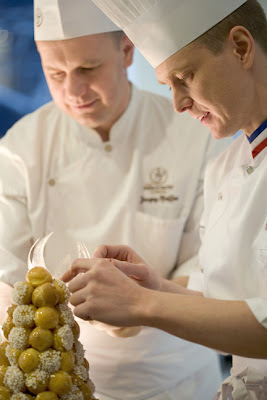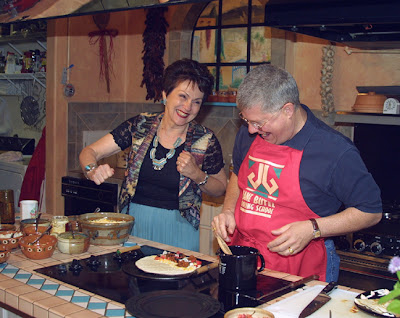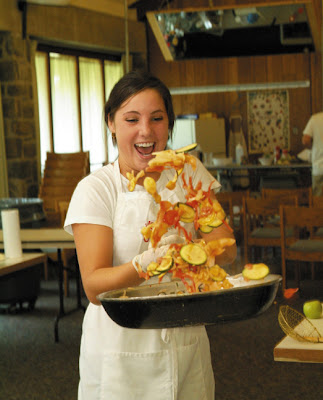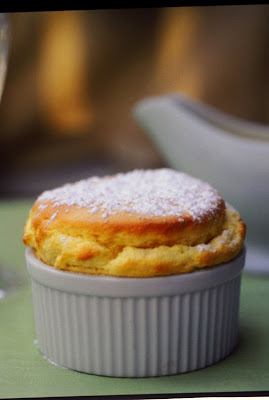I've got a great book to share with you today! Written by our Gourmet Getaways Editor, Joe David, it is entitled Gourmet Getaways: 50 Top Spots to Cook and Learn. Yes, you can tell he's going to be sharing great things with us on Wandering Educators! This wonderful book is PACKED with great information, inspiration, and recipes. It is an extraordinary resource, one that I have read again and again. The book is split up into five geographic regions in the US - Northeast, Southeast, Southwest, Midwest, and West. Each section has profiles of several cooking schools. Joe then discusses each cooking school - about the staff and/or chef, philosophy, classes, and a recipe (YUM!).

Jacquy Pfeiffer and Sébastien Cannone. Courtesy of the French Pastry School, photography by Paul Strabbing.
Each cooking school has me dreaming - of working with a particular chef, of learning a specific style of cooking, or even of each featured recipe. Whether it is learning about Georgia's Jekyll Island Club Hotel, the Captain Freeman Inn in Brewster, MA, the French Pastry School in Chicago, Hugh Carpenter's Camp Napa Culinary, or Joanne Weir's Cooking School in San Francisco, I am amazed at the depth of information about each place and chef that Joe shares with us - as well as how well he knows cooking. Truly, this book is an extremely valuable resource for anyone that loves food, cooking, and learning, written by a master.
We were lucky enough to sit down and chat with Joe about his new book, cooking schools, inspiration for teaching, and more. Here's what he had to say...
WE: Please tell us about your book, Gourmet Getaways...
JD: When I wrote Gourmet Getaways, I wanted it to be a comprehensive overview of the culinary getaways in the United States. I believe I achieved this by providing readers with enough information about what awaited them if they attended one of these getaways (i.e., programs, recreational activities, costs, facilities, lodging, food and non-food related activities, and most importantly, the chef’s background and philosophy of cooking). The latter, in my opinion, is so crucial to serious cooks who are interested in understanding what they will learn, if they attended a specific getaway.
But I didn’t just want the book to be of interest to traveling gourmets. To increase readership, I introduced important food-related matters by making the book a learning tool – with tips, recipes and cooking ideas that will appeal to both the stay-at-home cook and the traveling gourmet seeking a brief culinary getaway. For content balance, I have added some special information that should appeal to various types of readers – vegans, carnivores, and weight-watchers, for example.

Jane Butel of Jane Butel Cooking School; courtesy of Jane Butel.
WE: What was the impetus for you to write this book?
JD: In my article “It began with a stew,” I talk about my tragic childhood: my mother’s dislike for cooking. Fortunately, this childhood tragedy was mitigated by my dad’s fondness for stews. He would take mother’s mistakes in the kitchen and turn them into remarkable stews; if he couldn’t, because she had done such a thorough job of cremating the roast, he would take me downtown and introduce me to some of Chicago’s better restaurants. Thanks to his love for food and his willingness to share it, I grew up with an appreciation for fine dining.
As a writer, I didn’t immediately show any journalistic interest in food. For many years I focused my attention on writing about formal education (three books and numerous articles). It was quite by accident that I became interested in cooking programs. While traveling in the Far East, I stumbled upon the Oriental Hotel and discovered the hotel’s remarkable cooking program. Since I love Thai food, the culinary program there was an instant hit with me. This led to numerous articles on culinary schools around the world, and in 2006 to my article “World on a Plate” (Hemispheres, United Airlines in-flight magazine). As a result of this article, I was offered two book contracts. I accepted the one with my current publisher and the rest is history.

Joe David toasting his book launch at the National Press Club of Washington
WE: What is so attractive about cooking schools? What do people hope to achieve from taking cooking classes?
JD: A friend once remarked that she doesn’t trust anyone who didn’t enjoy food. Such people in her opinion tended to suppress pleasure. I don’t know how scientifically true this may be, but I do know that people who love to eat – like me – tend to approach life with a sense of adventure, a joie de vivre.
In recent years this love for food has become quite obvious in America. Food is so obviously being enjoyed everywhere, especially in restaurants, where chefs are producing original and tasty flavors. Visitors to such restaurants immediately experience the excitement of dining there.
Good food, whether it is served in a restaurant or in a private home, often brings out the best in people. A wise host/hostess wants to use this to his/her social advantage. Under the influence of good food, nothing else seems to matter for many of us. I’ve seen this happen often, everywhere, during my travels and in my home. It’s an amazing phenomenon. Food, tasty food, melts away other interests, at least temporarily and brings people together happily.

Julian Krinsky Cooking School. Photo courtesy Julian Krinsky group.
WE: Can you please share some basic guidelines for people looking to attend cooking classes?
JD: First, the reader must decide what he expects to gain from the experience. Once he understands what he wants from a school – a learning experience, a fun holiday, or just a gourmet getaway – he or she is in a position to evaluate wisely the choices I provide in my book. I recommend that each reader looks beyond the program’s glitz and examine the hard facts, but most importantly, understands the philosophy of each chef. It will give them an idea of what they will be taught and how.
Important: My evaluation of each school should not be taken as the final word. Programs change and personnel leave. Also, most schools must adapt to new trends. A few established schools rarely change and cling to their standards tenaciously. Point: always investigate the school before committing yourself to it by finding out as much as you can about the chef, his background, etc. It is your money and you want to spend it smartly.
WE: Was it great fun to research this book?
JD: Of course. I love to travel, and I use any excuse to hop a plane, bus or train. To go to some of America’s wonderful cities and visit secret and not-so-secret hideaways was a treat that will be long remembered. I chose this profession above all the others, not for riches, but for the mobility and an opportunity to be always a student. Digging into my subject, meeting some of the masters in the business is for me a priceless education.
WE: What inspires these chefs/cooks that teach?
JD: The great majority love food – and it shows by the way they approach it. A few, on the other hand, are ego-driven. Cooking is in, and they have put on an apron to take advantage of the opportunities. But the ones I like and I give special attention to are those who truly love what they do, and use food as way to express their creative spirit. When you step into a classroom with them – no matter how jaded you would think they would be from years of doing the same thing – you never see that. What you immediately see and feel is how much they love what they are doing. They light up and show a wonderful enthusiasm for what they are doing which becomes contagious. Of course, there are those few who don’t share this passion for their work, and they are in my opinion just cooks, often of limited ability.

Chef Patrick O'Connell. Photo courtesy of the Inn at little Washington.
WE: Is there anything else that you'd like to share with us?
JD: I remember a comment that Jacques Pépin once made to me. “You must never forget something very, very important,” he told me during an interview, “you must always be happy with what you do. And as Jean Brillat-Savarin once said, you must be willing to make your guests happy as well while under your roof. Never forget, even at the cost of your meal, that pleasing your guests is your most important concern. For this is truly the art of real entertainment.”

Chef Michael Salmon's Signature Souffle. Photo courtesy of the Hartstone Inn.
Chef Michael Salmon’s Signature Souffle
Tips and recipes from Chef Michael Salmon’s book In the Kitchen with Michael Salmon: Recipes of Distinction from the Hartstone Inn. Used with permission.
Soufflés have become Chef Michael’s signature dessert, and guests are always asking him for the recipe or a cooking class on soufflés. Making them can be tricky, so it it’s important that you follow the instructions carefully.
Timing is the key to successful soufflé service, as they wait for no one:
When they are ready to be served, they must be hastily escorted to the table
and consumed immediately, or they will become, as his wife, Mary Jo, says,
“flat tires.”
Michael has about thirty-five different flavor combinations that he uses for
his soufflés. While the following recipe has berries and Chambord (raspberry
liqueur), you can simply substitute these ingredients with one of the
following alternatives to create your favorite flavor:
Grand Marnier: 1/4 cup Grand Marnier
Chocolate-amaretto: ¼ cup cocoa powder, ¼ cup amaretto liqueur, and 2
tablespoons finely ground almonds
Pumpkin: ½ cup fresh canned pumpkin puree and 1 teaspoon pumpkin pie spice
Cappuccino: 2 tablespoons strong coffee or espresso and ¼ cup Kahlúa
Blueberry-hazelnut: ½ cup fresh or frozen blueberries, ¼ cup Frangelico
(hazelnut liqueur), and 2 tablespoons finely ground hazelnuts
Pistachio: ¼ cup finely ground pistachios and 2 tablespoons amaretto liqueur
Fresh Berry Soufflé with a Chambord Crème Anglaise
1 cup whole milk
2 oz unsalted butter (1/2 stick)
1/2 cup flour
1/2 cup granulated sugar
5 large eggs, separated
1 tablespoon unsalted butter, softened
2 tablespoons granulated sugar
1/2 cup fresh berries (raspberries, blackberries and sliced strawberries)
2 tablespoons Chambord
1/4 teaspoon cream of tartar
Chambord Crème Anglaise (recipe below)
1. In a 2-quart saucepan, heat the milk, over medium heat. In another 2-quart saucepan, melt the butter over medium heat.
When the butter is melted, stir in the flour and mix until combined well.
Reduce heat to low, and stir frequently.
2. When the milk comes to a simmer, stir in the sugar. Continue to stir,
dissolving the sugar for 2 minutes. Pour the milk mixture into the butter
mixture and stir with a whisk to combine, cooking over medium heat until a
ball forms and the mixture releases from the sides of the pan.
3. Immediately place the mixture in a mixing bowl and stir with an
electric mixer (using the flat paddle) on medium-low speed for 10 minutes.
4. One by one, stir in the egg yolks, allowing each to be completely
incorporated before adding the next. When all of the egg yolks are
incorporated, set the mixture (soufflé base) aside and allow it to cool.
This base will keep refrigerated for up to 1 week.
5. Generously butter four 1 1/2 cup soufflé dishes, covering the entire
surface area on the inside of the cups, including the rim. Coat the buttered
cups with granulated sugar, rotating the cups to coat them evenly. Tap out
any excess sugar. Set the prepared cups aside.
6. Place the soufflé base in a mixing bowl and stir in half the berries, mixing well. Add the Chambord, mixing well.
7. Preheat the oven to 350 degrees.
8. In an electric mixer fitted with a whisk, whip the egg whites and cream
of tartar until stiff peaks form. With a large rubber spatula, gently fold
half of the egg whites into the base. Continue to fold in the remaining egg
whites. Gently pour the batter into the prepared soufflé dishes, filling
them four-fifths of the way full. Be careful not to drip the batter on the
rims, or the soufflés may not rise evenly.
9. Bake in the center of the oven for 35 minutes, or until lightly browned on
top. Remove from the oven, place on a small serving plate and top with a
small mound of the reserved fresh berries. Dust with powdered sugar and
hurry the soufflés to the table. Serve the soufflés with a side of Chambord
Crème Anglaise, pouring the Crème Anglaise into a hole poked in the top of
the soufflé at the table. Eat immediately.
Makes 4 soufflés
Chambord Crème Anglaise
2 cups whole milk
3 large eggs
2 egg yolks
1/2 cup granulated sugar
1/2 cup fresh raspberries
1 tablespoon Chambord
1. In a 2-quart saucepan over a medium-high heat, bring the milk to a
simmer.
2. In a medium-sized mixing bowl, whisk together the eggs, egg yolks
and sugar. Have ready a large bowl half full of ice water (with plenty of
ice) and a medium-sized bowl that will fit inside the ice bath. Also have a
fine mesh strainer, a wooden spoon, and an instant read thermometer.
3. When the milk reaches a simmer, slowly pour about 1/2 cup of the
hot milk into the egg mixture, whisking constantly. (This is called
tempering.) Add another 1/2 cup of hot milk, whisking constantly. Now whisk
the tempered egg mixture back into the saucepan with the milk, whisking
constantly. Set the whisk aside and stir this mixture with the wooden spoon
constantly over medium heat until the mixture reaches a temperature of 175
degrees on the instant-read thermometer or until the mixture just coats the
back of the spoon. Remove from the heat and immediately pour the mixture
through the fine mesh strainer into the medium bowl. Immediately set this
bowl in the ice bath to stop the cooking. Stir the mixture, occasionally,
until it cools. Stir in the fresh raspberries and Chambord.
4. Refrigerate in a covered container until needed, for up to 1 week.
Serves 5-6
WE: Thanks so very much, Joe. This recipe sounds divine. And your book? We highly recommend it to our readers. I just love it.
